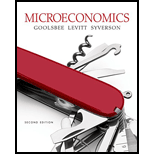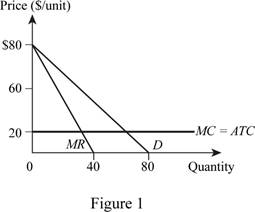
(a)
The competitive output and the
(a)
Explanation of Solution
When the market is competitive, the price will be determined such that the marginal cost equals price. Here, the marginal cost is given to be $20, which means that the competitive price in the market will be $20. The output in the market can be calculated by substituting the price in the
Thus, the
Imperfect competition: Imperfect competition is the market structure where there are many sellers selling the differentiated products, and there will be information asymmetry in the market, which provides some market control to the producers.
(b)
The
(b)
Explanation of Solution
The marginal revenue of the firm can be derived as follows:
Thus, the marginal revenue curve will be
Thus, the marginal revenue curve can be illustrated as follows:

(i) The competitive output was 60 units, whereas the monopoly output is calculated to be just 30 units. Thus, the proportion of the two market condition outputs can be written as follows:
Thus, the proportion is
(ii) The monopoly price can be calculated by substituting the value of Q in the demand equation as follows:
Thus, the market situation can be illustrated as follows:

In Figure 2, the horizontal axis measures quantity, and the vertical axis measures price.
(c)
Output and price under the Cournot competition.
(c)
Explanation of Solution
Under the Cournot competition, there will be two players in the market producing the identical products. Thus, the inverse demand function of the market would be
Marginal revenue of firm 1 can be derived as follows:
Thus, the marginal revenues of the firm 1 is
Marginal revenue of firm 2 can be derived as follows:
Thus, the marginal revenue of the firm 2 is
Similarly, the reaction function of firm 2 can be calculated as follows:
The output of the firm 1 can be calculated by substituting the reaction function of 2 in the reaction function of 1 as follows:
Since both firms face the identical problem, both would produce 20 units each, and the total industrial output would become 40.
(i) The competitive output was 60 units, whereas the cournot output is calculated to be just 40 units. Thus, the proportion of the two market condition outputs can be written as follows:
Thus, the proportion is
(ii) The Cournot price can be calculated by substituting the value of Q in the demand equation as follows:
Thus, the market situation can be illustrated as follows:

In Figure 3, the horizontal axis measures quantity, and the vertical axis measures price.
(d)
Output and price under the 3 player Cournot competition.
(d)
Explanation of Solution
Under the three-player cournot competition, the inverse demand function of the market would be
Marginal revenue of firm 1 can be derived as follows:
Thus, the marginal revenues of the firm 1 is
Marginal revenue of firm 2 can be derived as follows.
Thus, the marginal revenue of the firm 2 is
Marginal revenue of firm 2 can be derived as follows:
Thus, the marginal revenue of the firm 2 is
All the firms face the marginal cost. The quantity of individual firs is equal
Similarly, the reaction function of other firms will be the same. Thus, each firm would produce 15 units each. Thus, the fraction of output would be equal to
(e)
Fraction of output when there are N firms in the market.
(e)
Explanation of Solution
When there are N identical firms in the market, then there will be N fractions produced in the market. Thus, the fraction of output brought to the market by each firm can be written as
(f)
Impact when there are N firms in the market.
(f)
Explanation of Solution
When there are N identical firms in the market, each firm would produce an identical output, which leads the market to converge into a competitive equilibrium. Thus, the price would also tend to move toward the competitive price in the market. Thus, the
Want to see more full solutions like this?
Chapter 11 Solutions
Microeconomics
- agrody calming Inted 001 and me 2. A homeowner is concerned about the various air pollutants (e.g., benzene and methane) released in her house when she cooks with natural gas. She is considering replacing her gas oven and stove with an electric stove comprising an induction cooktop and convection oven. The new appliance costs $900 to purchase and install. Capping the old gas line costs an additional $150 (a one-time fee). The old line must be inspected for leaks each year after capping, at a cost of $35 for each inspection. a. If the homeowner plans to remain in the house for four more years and the discount rate is 4%, what is the minimum present value of the benefits that the homeowner would need to experience for this purchase to be justified based on its private net sub present value? b. While trying to understand how she might express the value of reduced exposure to indoor air pollutants in dollar terms, the homeowner consulted the EPA website and found estimates provided by…arrow_forwardAfter the ban is imposed, Joe’s firm switches to the more expensive biodegradable disposable cups. This increases the cost associated with each cup of coffee it produces. Which cost curve(s) will be impacted by the use of the more expensive biodegradable disposable cups? Why? Which cost curve(s) will not shift, and why not? Please use the table below to answer this question. For the second column (“Impacted? If so, how?”), please use one of the following three choices: No shift; Shifts up (i.e., increases: at nearly any given quantity, the cost goes up); or Shifts down (i.e., decreases: at nearly any given quantity, the cost goes down). $ Cost Curve Impacted? If so, how? Explanation of the Shift: Why or Why Not AFC No shift. Fix costs stay the same, regardless of quantity. Fixed cost is calculated as Fixed Cost/Quantity. Since fixed costs remain unchanged, AFC stays the same for each quantity. MC Shifts up. Since the biodegradable cups are more expensive, the…arrow_forwardStyrofoam is non-biodegradable and is not easily recyclable. Many cities and at least one state have enacted laws that ban the use of polystyrene containers. These locales understand that banning these containers will force many businesses to turn to other more expensive forms of packaging and cups, but argue the ban is environmentally important. Shane owns a firm with a conventional production function resulting in U-shaped ATC, AVC, and MC curves. Shane's business sells takeout food and drinks that are currently packaged in styrofoam containers and cups. Graph the short-run AFC0, AVC0, ATC0, and MC0 curves for Shane's firm before the ban on using styrofoam containers.arrow_forward
- PART II: Multipart Problems wood or solem of triflussd aidi 1. Assume that a society has a polluting industry comprising two firms, where the industry-level marginal abatement cost curve is given by: MAC = 24 - ()E and the marginal damage function is given by: MDF = 2E. What is the efficient level of emissions? b. What constant per-unit emissions tax could achieve the efficient emissions level? points) c. What is the net benefit to society of moving from the unregulated emissions level to the efficient level? In response to industry complaints about the costs of the tax, a cap-and-trade program is proposed. The marginal abatement cost curves for the two firms are given by: MAC=24-E and MAC2 = 24-2E2. d. How could a cap-and-trade program that achieves the same level of emissions as the tax be designed to reduce the costs of regulation to the two firms?arrow_forwardOnly #4 please, Use a graph please if needed to help provearrow_forwarda-carrow_forward
- For these questions, you must state "true," "false," or "uncertain" and argue your case (roughly 3 to 5 sentences). When appropriate, the use of graphs will make for stronger answers. Credit will depend entirely on the quality of your explanation. 1. If the industry facing regulation for its pollutant emissions has a lot of political capital, direct regulatory intervention will be more viable than an emissions tax to address this market failure. 2. A stated-preference method will provide a measure of the value of Komodo dragons that is more accurate than the value estimated through application of the travel cost model to visitation data for Komodo National Park in Indonesia. 3. A correlation between community demographics and the present location of polluting facilities is sufficient to claim a violation of distributive justice. olsvrc Q 4. When the damages from pollution are uncertain, a price-based mechanism is best equipped to manage the costs of the regulator's imperfect…arrow_forwardFor environmental economics, question number 2 only please-- thank you!arrow_forwardFor these questions, you must state "true," "false," or "uncertain" and argue your case (roughly 3 to 5 sentences). When appropriate, the use of graphs will make for stronger answers. Credit will depend entirely on the quality of your explanation. 1. If the industry facing regulation for its pollutant emissions has a lot of political capital, direct regulatory intervention will be more viable than an emissions tax to address this market failure. cullog iba linevoz ve bubivorearrow_forward

 Principles of Economics (12th Edition)EconomicsISBN:9780134078779Author:Karl E. Case, Ray C. Fair, Sharon E. OsterPublisher:PEARSON
Principles of Economics (12th Edition)EconomicsISBN:9780134078779Author:Karl E. Case, Ray C. Fair, Sharon E. OsterPublisher:PEARSON Engineering Economy (17th Edition)EconomicsISBN:9780134870069Author:William G. Sullivan, Elin M. Wicks, C. Patrick KoellingPublisher:PEARSON
Engineering Economy (17th Edition)EconomicsISBN:9780134870069Author:William G. Sullivan, Elin M. Wicks, C. Patrick KoellingPublisher:PEARSON Principles of Economics (MindTap Course List)EconomicsISBN:9781305585126Author:N. Gregory MankiwPublisher:Cengage Learning
Principles of Economics (MindTap Course List)EconomicsISBN:9781305585126Author:N. Gregory MankiwPublisher:Cengage Learning Managerial Economics: A Problem Solving ApproachEconomicsISBN:9781337106665Author:Luke M. Froeb, Brian T. McCann, Michael R. Ward, Mike ShorPublisher:Cengage Learning
Managerial Economics: A Problem Solving ApproachEconomicsISBN:9781337106665Author:Luke M. Froeb, Brian T. McCann, Michael R. Ward, Mike ShorPublisher:Cengage Learning Managerial Economics & Business Strategy (Mcgraw-...EconomicsISBN:9781259290619Author:Michael Baye, Jeff PrincePublisher:McGraw-Hill Education
Managerial Economics & Business Strategy (Mcgraw-...EconomicsISBN:9781259290619Author:Michael Baye, Jeff PrincePublisher:McGraw-Hill Education





